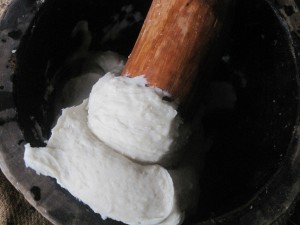In the heart of the gastronomical art of the people south of the Sahara is the delight of swallowing. Around mounds of hot dough made out of yam, or rice, or potatoes, or corn, or even millet, bowls of soup lay spread on a mat in the middle of a salivating family. Dinner time is more than just the conversation that lubricates the passing of each balls of dough through the oesophagus into the waiting bellies, it is an appreciation of the craft behind the cooking, and the process of eating. Feeding is an art in itself. I see it now: bowls of pounded yam along with egusi soup, hot plates of amala on which ewedu and gbegiri compete for dominance, and all around the plate surrounding small reefs of fried beef. It is the pleasure to behold, and the pleasure to hold on the tongue before the final swallowing.
 So a friend from Jamaica had encountered pounded yam for the very first time, and looked bewildered at the suggestion that each handful of a rounded ball of the dough already coated in soup had to be swallowed in entirety. “This is too large for my throat,” she said. I took another look at pounded yam today and discovered that she was right. Contrary to the suggestion that all you do is throw the ball of food in your mouth and swallow it, the process before the swallowing is actually a little more complicated. It starts with a swirling on the tongue of the food in order to separate what’s “food” and what’s “sauce”. A little teeth-work takes place afterwards to press whatever is necessary into the right shape for the throat. Everything else follows.
So a friend from Jamaica had encountered pounded yam for the very first time, and looked bewildered at the suggestion that each handful of a rounded ball of the dough already coated in soup had to be swallowed in entirety. “This is too large for my throat,” she said. I took another look at pounded yam today and discovered that she was right. Contrary to the suggestion that all you do is throw the ball of food in your mouth and swallow it, the process before the swallowing is actually a little more complicated. It starts with a swirling on the tongue of the food in order to separate what’s “food” and what’s “sauce”. A little teeth-work takes place afterwards to press whatever is necessary into the right shape for the throat. Everything else follows.
It is safer to say that whenever you get a delightful ball of Yoruba food (be it pounded yam, amala or semo) into your mouth along with accompanying spiced vegetables, you may just trust your tongue and teeth to sort out the rest of the job. It goes into the mouth as a ball of dough, but eventually relaxes into something smoother before a delightful passage into the warm embrace of the gut. The pleasure, eventually, is in the eating. Here therefore is a salute not just to the art of cooking and the long history of efforts behind it, but also to those who revel in its delightful consumption, especially across cultural lines. Feeding, after all is an artful exercise. (In other words, you could just say that I do terribly miss my pounded yam.)
10 Comments to The Pleasure of Swallowing so far. (RSS Feeds for comments in this post)